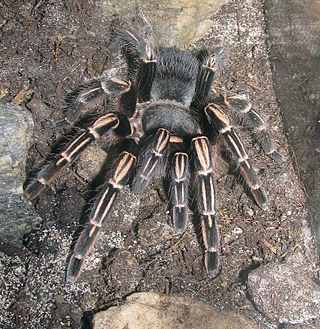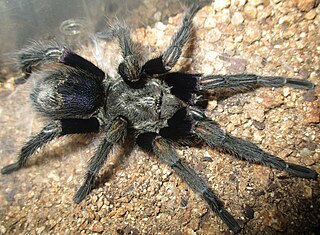
Avicularia is a genus of the family Theraphosidae containing various species of arboreal tarantulas. The genus is native to Panama, the Caribbean and tropical South America. Each species in the genus has very distinguishable pink foot pads.

Brachypelma is a genus of spiders in the family Theraphosidae (tarantulas). They may have bodies up to 6 cm long with legs of similar or greater lengths. Some species have brightly colored legs, with red or orange marks and rings.

Aphonopelma is a genus of tarantulas native to the Americas. It includes nearly all the North American tarantula species north of Mexico and a considerable percentage of the tarantula species that range into Central America. Most are fairly large tarantulas with leg spans of 6 in (16 cm) or more. Like most New World tarantulas, all species of Aphonopelma have urticating hairs. Despite their fearsome appearance, these tarantulas are not harmful to humans and some species are popular in the pet trade. With about 90 species described so far, Aphonopelma comprises about 10% of the total number of described tarantula species. However, their taxonomy is poorly understood and species are difficult to tell apart, especially those that are brown or black without other pattern. Therefore, the actual number of species is unknown, with more species likely to be identified in the near future. In captivity, they are usually fed crickets; in the wild, they eat most insects, including crickets, grasshoppers, cockroaches, mantises, and beetles.

Tliltocatl vagans is a species of tarantula known commonly as the Mexican red rump. It ranges predominantly in Mexico, but is also found in Central America. They are terrestrial, burrowing spiders. The reason for the name red rump is because of its distinctive red hairs on its abdomen. Like most tarantulas, they will eat anything they can overpower, which is usually insects, but small lizards and rodents may also be consumed. They can grow up to a solid 6.5 inch leg span, with males typically being smaller and thinner than the females. They prefer shrubland habitats.

Euathlus is a genus of South American tarantulas that was first described by Anton Ausserer in 1875. These spiders are medium sized and are usually found in high elevations in the Andes. It is a senior synonym of Paraphysa, and was formerly considered a senior synonym of Brachypelma, but this was later rejected.

Tarantulas comprise a group of large and often hairy spiders of the family Theraphosidae. As of December 2023, 1,100 species have been identified, with 166 genera. The term "tarantula" is usually used to describe members of the family Theraphosidae, although many other members of the same infraorder (Mygalomorphae) are commonly referred to as "tarantulas" or "false tarantulas". Some of the more common species have become popular in the exotic pet trade. Many New World species kept as pets have setae known as urticating hairs that can cause irritation to the skin, and in extreme cases, cause damage to the eyes.

Brachypelma albiceps is a species of spider in the tarantula family, Theraphosidae. It is known as the Mexican golden red rump tarantula or the Amula red rump tarantula. The carapace is a light golden color and the abdomen dark, covered with long red hairs. Females typically live for about 15 years. Males usually live about 5 years or up to 12 months after the last molt.
Cyclosternum is a genus of tarantulas that was first described by Anton Ausserer in 1871.
Aphonopelma chamberlini, also known as the Paso Robles rusty red tarantula, is regarded by some sources as a tarantula species endemic to California, and by others as synonymous with Aphonopelma iodius.

Aphonopelma johnnycashi is a species of tarantula. It was found in 2015 near Folsom Prison in California and named after Johnny Cash, whose song "Folsom Prison Blues" made the prison famous. Mature males are generally black, and the country music singer was also known as "The Man in Black".

Aphonopelma steindachneri is a species of spider in the family Theraphosidae, found in United States (California) and Mexico.

Aphonopelma moderatum is a species of spider in the family Theraphosidae, found in United States, in the state of Texas. Commonly called the Rio Grande Gold Tarantula as they are found in the Rio Grande Valley of Texas.

Aphonopelma vorhiesi is a species of spider in the family Theraphosidae, found in Arizona and New Mexico. This species looks similar to the Aphonopelma chalcodes, but it is far more rare in captivity.
Aphonopelma phasmus is a species of spider in the family Theraphosidae. It is only known from a single adult male collected near the Colorado River in the Grand Canyon National Park in Coconino County, Arizona. The female is unknown.
Sandinista lanceolatum is a species of spider in the family Theraphosidae (tarantulas), native to Nicaragua and Costa Rica.

Tliltocatl verdezi is a species of spiders in the family Theraphosidae (tarantulas), found in Mexico.
Sericopelma angustum, is a species of spider in the family Theraphosidae found in Costa Rica The species was formerly included in the genus Brachypelma.

Tliltocatl is a genus of North American tarantulas that was split off from Brachypelma in 2020. They are also large burrowing tarantulas, but don't have the striking red leg markings of Brachypelma species. A female T. vagans can grow up to 50 mm (2.0 in) long and legs can get as long as 55 mm (2.2 in). They are found predominantly in Mexico, with some species native to Central America. The name is derived from two Nahuatl words, "tlil", meaning "black", and "tocatl", meaning "spider". Habitat destruction and collection for the pet trade has led to this and Brachypelma to be protected under International Convention on International Trade of Endangered Species rules, beginning with B. smithi.

Sericopelma embrithes is a tarantula that is native to Panama. To date, only specimens from Barro Colorado Island have been studied. Like other tarantulas, it is relatively large compared to other spiders. It can grow up to 59 mm long, including its chelicerae. S. embrithes is data deficient according to the IUCN.














